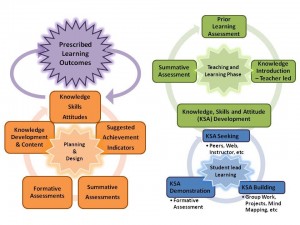OLTD Learning Outcome:
- Critically assess and evaluate resources for best practice in online learning
Evidence to Support Outcome:
Reflection to Support Evidence:
The evidence I have chosen to support my learning outcome was developed in October 2013 as part of OLTD 501. This inquiry based action plan includes background information and context for my guiding research question, as well as the start of an annotated bibliography. The research databases utilized were ERIC as well as Google Scholar.
My guiding research question is: What are the ways that an authentic scientific experience, either through experimentation or through other methods, can be created in an online and/or asynchronous environment?
My inquiry based action plan allowed me to develop research skills. During the process of selecting three articles for the annotated bibliography, I was able to review more the ten different research studies and articles around my research question, as well as searching through and reading the abstracts for many more.
As the outcome speaks specifically to critically assessing and evaluating resources, the process of creating my inquiry based action plan directly relates to developing this competency. Throughout the remainder of the OLTD program I will continue to develop my critical assessment and research skill and hope to continue to expand my bibliography of resources.
The articles and papers I have read so far have helped me to develop different ideas about conducting laboratory activities in an online environment. Throughout the development of my inquiry based action plan I have gained knowledge about the different research-based options are available for laboratory activities, and which ones students prefer. I will be able to integrate different activities for students into my lesson and course plans, hopefully providing a space for didactic conversation and authentic, motivating learning experiences. I hope to build in multiple learning opportunities for student to develop not only knowledge, but skills and attitudes in an authentic scientific community of learners.
It is important to keep up to date on the newest methods to enhance student success, as well as continuing to learn and grow professionally. Without the ability to critically assess the information that is being presented, it is difficult to build an effective teaching practice or philosophy. Teaching resources and information should be held to a high standard, and critical assessment is crucial to separating helpful resources from less helpful ones.
I hope to continue to develop my ability to assess resources, as well as search for and find resources that will help to develop my practice.
